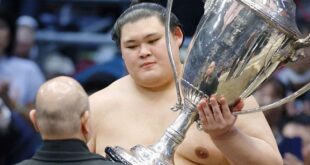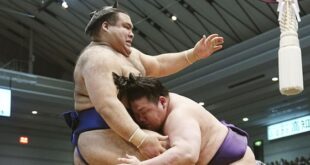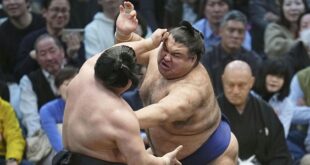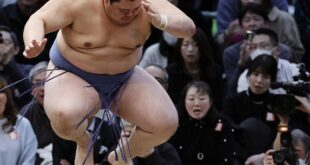Haru basho 2016 : résultats de la finale (senshûraku)
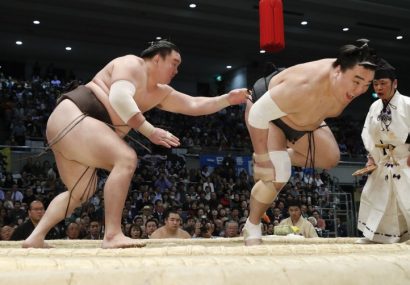
Finale – Hakuho remporte son 36ème yusho
On n’a pas eu droit à la belle finale tant espérée, Hakuho n’a pas été au contact de son compatriote Harumafuji pour remporter ce dimanche son 36ème titre lors de la dernière journée du Grand Tournoi de Sumo de printemps.
Avec juste une défaite, Hakuho s’est imposé presque sans combattre, ce qui n’a pas été du goût des amateurs de sumo, en utilisant une technique de « henka » c’est à dire en esquivant la charge de son adversaire Harumafuji (9-6), ce qui a déclenché des huées et des quolibets de certains spectateurs.
Le plus grand champion de l’histoire du sumo domine depuis plusieurs années la division makuuchi mais n’avait pas gagné de titre depuis le tournoi de Nagoya en juillet de l’année dernière.
Hakuho, dont la défaite est survenu lors de la journée d’ouverture s’est excusé pour avoir utilisé un henka mais des centaines de spectateurs avaient déjà quitté les lieux sans attendre son interview d’après match.
« Ça faisait huit mois que je n’avais pas gagné, ça m’a semblé long »
Hakuho, très ému, a marqué de longues pauses entre chaque réponse tout en essayant de contenir ses larmes.
« Perdre (le premier jour du tournoi) était comme une bonne dose de médicament pour moi. Je me suis battu dès le deuxième jour mais je ne pensais gagner la finale par henka et je me sens vraiment mal à ce propos. »
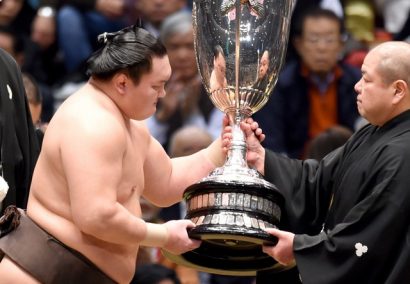
Dans la rencontre qui opposait les seuls lutteurs avec juste deux défaites et donc encore un espoir de titre, Kisenosato (13-2) a maîtrisé de bout en bout Goeido (12-3) pour le sortir en ligne droite.
Le yokozuna Kakuryu termine ce tournoi sur une 10ème victoire en projetant à terre Kotoshogiku (8-7). L’ôzeki, qui avait pourtant commencé le championnat avec l’espoir d’une promotion au rang de yokozuna, n’a guère brillé durant cette quinzaine et termine sur un score mitigé.
Kotoyuki est sorti victorieux de sa rencontre face au chouchou local Ikioi (10-5) à l’issu d’un match de boxe très excitant. Kotoyuki, qui a vaincu un yokozuna et deux ôzeki, fini sur un excellent 12-3. Le maegashira 1 a par ailleurs été récompensé pour sa performance exceptionnelle par son premier shukun shô.
« Ce fut un combat rapproché (contre Ikioi) mais j’ai été patient et j’ai fait mieux que prévu » a déclaré Kotoyuki. « Chaque jour a été enrichissant et j’ai appris beaucoup de choses, j’ai gagné en confiance« .
Le maegashira 4 Ikioi (10-5) a également fait un beau parcours mais sa défaite lors du dernier combat le prive d’un sanshô. En effet, Ikioi pouvait espérer gagner le kantô shô (prix de l’esprit combatif) qu’à condition d’obtenir 11 victoires. Aucun ginô shô (prix de la technique) n’a été décerné pour la deuxième fois d’affilée.
Le bulgare Aoiyama (7-8) a condamné encore un peu plus Toyonoshima en le poussant vers sa 12ème défaite. Le japonais aura juste eu le temps de faire un aller-retour en tant que sekiwake.
Yoshikaze (4-11) a lui aussi fait un tournoi décevant bien qu’il ai terminé par une victoire face à l’ôzeki Terunofuji (8-7).
Le maegashira 11 Ichinojo (11-4) a fini en beauté après avoir obtenu une prise ferme à la ceinture de son adversaire. Le géant mongol a infligé à Sadanoumi un make koshi (7-8)
Les lutteurs kachi koshi du jour sont :
Jûryô : Chiyoo, Ishiura et Asabenkei
Les lutteurs make koshi du jour sont :
Jûryô : Chiyomaru, Tsurugisho et Azumaryu
English article by Kyodo :
Hakuho wins 36th career title at Spring basho
It was not pretty, but Hakuho defeated fellow Mongolian yokozuna Harumafuji to capture a record-extending 36th career championship title with a 14-1 record on Sunday, the final day of the Spring Grand Tournament.
Entering the day in control of his own fate with a one-win lead, Hakuho used a frowned-upon henka sidestep technique at the charge to avenge three straight defeats to Harumafuji (9-6), triggering boos and jeers among the sold-out crowd at Edion Arena Osaka.
The most successful wrestler in sumo history, Hakuho has dominated the top makuuchi division in recent years but had not won a championship title since the Nagoya meet in July last year.
Hakuho, whose only defeat here came on the opening day, apologized for using a henka but hundreds of spectators had already left the arena before his post-match interview.
« Winning a championship has seemed far away over these last eight months, » said Hakuho, who took log pauses before answering as he struggled to hold back tears.
« Losing (on the first day of the tournament) was a good dose of medicine for me. I wrestled well from the second day but I never planned to win on the final day with a henka and I feel really bad about that. »
In a matchup between the only other wrestlers still in with a shot at the title coming into the final day, Kisenosato claimed ozeki bragging rights and closed at 13-2 by muscling out Goeido (12-3).
Mongolian yokozuna Kakuryu floored ozeki Kotoshogiku with an underarm throw for a 10th win. Kotoshogiku, who started the meet with hopes of promotion to grand champion after a surprise championship win at the New Year meet, finished with an 8-7 mark.
In other bouts of note, Kotoyuki emerged victorious from an entertaining slugfest against local favorite Ikioi for a 12-3 record. The top-ranked maegashira, who beat one yokozuna and two ozeki en route to double-digit wins, won his first Outstanding Performance prize.
« It was a close fight (against Ikioi) but I was patient and did better than I expected, » said Kotoyuki. « Every day has been fulfilling and I have learned lessons and gained confidence. »
Fourth-ranked Ikioi (10-5) has also had an impressive showing here but failure to score an 11th win saw him miss out on the Fighting Spirit Prize. There was no Technique Prize awarded for the second tournament in a row.
Bulgarian-born No. 3 maegashira Aoiyama (7-8) piled more misery on Toyonoshima, thrusting him out to condemn him to a 12th defeat on his return to sumo’s third highest rank of sekiwake.
Sekiwake Yoshikaze (4-11) has also had a disappointing tournament, although he was able to finish on a winning note by outmuscling Mongolian ozeki Terunofuji (8-7).
No. 11 maegashira Ichinojo (11-4) finished with a flourish, the Mongolian giant getting a firm left-handed grip on Sadanoumi’s belt and marching the ninth-ranked grappler out to an eighth loss.
Written by Kyodo
Crédits photos : Asahi
Champions par division :
Makuuchi : Hakuho (14-1)
Yokozuna – Miyagino beya
Jûryô : Osunaarashi (13-2)
Est 1 – Otake beya
Makushita : Sato (7-0)
Est 9 – Takanohana beya
Sandanme : Oyanagi (7-0)
Est 100 – Tokitsukaze beya
Jonidan : Kotodaigo (7-0)
Est 44 – Sadogatake beya
Jonokuchi : Asatamaki (7-0)
Ouest 19 – Takasago beya
Shukun-shô :
Kotoyuki (M1)
Kantô-shô :
non attribué
Ginô-shô :
non attribué
Bilan du haru basho 2016 :
Record pour :
Kinboshi attribué à :
Mention à :
Déception pour :
- Parution du banzuke : 25 avril
- Début du tournoi : 8 mai
- Fin du tournoi : 22 mai
Lieu : Tokyo (Ryogoku Kokugikan)
Merci à tous d’avoir suivi le tournoi jour après jour sur Dosukoi mais l’actualité du sumo continue même en dehors des basho. Toutes les informations des événements à venir sont sur notre site. N’oubliez pas de nous rejoindre sur les réseaux sociaux, suivez-nous sur Facebook, Google + et Twitter et abonnez-vous à notre chaîne YouTube. N’hésitez pas à aussi partager les articles sur ces réseaux et à les commenter.
Merci à Kintamayama pour ses vidéos quotidiennes et à tous nos lecteurs.
Dernière journée
|
Rikishis
|
Kimarite
|
Rikishis
|
|
Asabenkei |
 |
|
oshidashi
押し出し |
|
 |
Akua |
|
Tenkaiho
天鎧鵬 貴由輝 (Juryô 11) 6-9 |
 |
|
abisetaoshi
浴せ倒し |
|
 |
Terutsuyoshi
(Makushita 3) 3-4 |
|
Dewahayate |
 |
|
yorikiri
寄り切り |
|
 |
Azumaryu
東龍 強 (Juryô 7) 7-8 |
|
Chiyonokuni
千代の国 (Juryô 7) 9-6 |
 |
|
uwatenage
上手投げ |
|
 |
Tsurugisho
剣翔 (Juryô 9) 7-8 |
|
Onosho
阿武咲 奎也 (Juryô 12) 5-10 |
 |
|
yorikiri
寄り切り |
|
 |
Jôkôryû
常幸龍 貴之 (Juryô 6) 5-10 |
|
Endo
遠藤 聖大 (Juryô 6) 11-4 |
 |
|
okuritaoshi
送り倒し |
|
 |
Chiyomaru
千代丸 (Juryô 11) 7-8 |
|
Asahishô
旭日松 広太 (Juryô 9) 7-8 |
 |
|
hikiotoshi
引き落とし |
|
 |
Kagamio
鏡桜 南二 (Juryô 5) 4-11 |
|
Arawashi
荒鷲 毅 (Juryô 5) 8-7 |
 |
|
yorikiri
寄り切り |
|
 |
Ishiura
石浦 将勝 (Juryô 8) 8-7 |
|
Shotenro
翔天狼 大士 (Juryô 14) 3-9-3 |
 |
|
tsukiotoshi
突き落とし |
|
 |
Kagayaki
輝 大士 (Juryô 4) 7-8 |
|
Sadanofuji
佐田の富士 (Juryô 4) 7-8 |
 |
|
oshitaoshi
押し倒し |
|
 |
Kyokutaisei
旭大星 託也 (Juryô 14) 6-9 |
|
Chiyoo
千代皇 (Juryô 10) 8-7 |
 |
|
oshidashi
押し出し |
|
 |
Homarefuji
誉富士 歓之 (Juryô 3) 8-7 |
|
Fujiazuma
富士東 和佳 (Juryô 3) 5-10 |
 |
|
uwate dashinage
上手出し投げ |
|
 |
Chiyoshoma
千代翔馬 (Juryô 10) 11-4 |
|
Amakaze
天風 (Juryô 13) 9-6 |
 |
|
oshidashi
押し出し |
|
 |
Nishikigi
錦木 徹也 (Juryô 2) 10-5 |
|
Asasekiryû
朝赤龍 太郎 (Juryô 2) 4-11 |
 |
|
oshitaoshi
押し倒し |
|
 |
Kitaharima
北はり磨 聖也 (Juryô 8) 9-6 |
MAKUUCHI
|
Rikishis
|
Kimarites
|
Rikishis
|
|
Satoyama
里山 浩作 (Maegashira 15) 6-9 |
 |
|
shitatenage
下手投げ |
|
 |
Seiro
青狼 武士 (Juryô 1) 9-6 |
|
Daishomaru
大翔丸 翔伍 (Maegashira 14) 8-7 |
 |
|
oshidashi
押し出し |
|
 |
Osunaarashi
大砂嵐 金太 (Juryô 1) 13-2 |
|
Chiyootori
千代鳳 祐樹 (Maegashira 13) 8-7 |
 |
|
okuridashi
送り出し |
|
 |
Amuru
阿夢露 光大 (Maegashira 11) 7-8 |
|
Gagamaru
臥牙丸 勝 (Maegashira 10) 5-10 |
 |
|
oshidashi
押し出し |
|
 |
Tamawashi
玉鷲 一朗 (Maegashira 10) 9-6 |
|
Ichinojo
逸ノ城 駿 (Maegashira 11) 11-4 |
 |
|
yorikiri
寄り切り |
|
 |
Sadanoumi
佐田の海 貴士 (Maegashira 9) 7-8 |
|
Takanoiwa
貴ノ岩 義司 (Maegashira 8) 8-7 |
 |
|
yorikiri
寄り切り |
|
 |
Kitataiki
北太樹 明義 (Maegashira 15) 3-12 |
|
Akiseyama
明瀬山 光彦 (Maegashira 16) 4-11 |
 |
|
oshidashi
押し出し |
|
 |
Kaisei
魁聖 一郎 (Maegashira 7) 11-4 |
|
Takekaze
豪風 旭 (Maegashira 7) 5-10 |
 |
|
oshidashi
押し出し |
|
 |
Daieisho
大栄翔 勇人 (Maegashira 14) 10-5 |
|
Mitakeumi
御嶽海 (Maegashira 13) 10-5 |
 |
|
yorikiri
寄り切り |
|
 |
Shodai
正代 (Maegashira 6) 9-6 |
|
Myogiryu
妙義龍 泰成 (Maegashira 6) 10-5 |
 |
|
tsukidashi
突き出し |
|
 |
Chiyotairyû
千代大龍 秀政 (Maegashira 8) 3-12 |
|
Kyokushuho
旭秀鵬 滉規 (Maegashira 5) 6-9 |
 |
|
yorikiri
寄り切り |
|
 |
Tokushôryû
徳勝龍 誠 (Maegashira 12) 8-7 |
|
Toyohibiki |
 |
|
hatakikomi
叩き込み |
|
 |
Tochinoshin
栃ノ心 剛 (Maegashira 2) 6-9 |
|
Okinoumi
隠岐の海 歩 (Maegashira 2) 8-7 |
 |
|
oshidashi
押し出し |
|
 |
Aminishiki
安美錦 竜児 (Maegashira 3) 7-8 |
|
Hidenoumi |
 |
|
uwatenage
上手投げ |
|
 |
Takayasu |
|
Kotoyuki
琴勇輝 一巖 (Maegashira 1) 12-3 |
 |
|
hikiotoshi
引き落とし |
|
 |
Ikioi
勢 翔太 (Maegashira 4) 10-5 |
|
Shôhôzan
松鳳山 裕也 (Maegashira 5) 4-11 |
 |
|
oshidashi
押し出し |
|
 |
Takarafuji
宝富士 大輔 (Komusubi) 6-9 |
|
Tochiôzan
栃煌山 雄一郎 (Komusubi) 4-11 |
 |
|
okuridashi
送り出し |
|
 |
Sokokurai
蒼国来 栄吉 (Maegashira 4) 5-8-2 |
|
Aoiyama
碧山 亘右 (Maegashira 3) 7-8 |
 |
|
tsukidashi
突き出し |
|
 |
Toyonoshima
豊ノ島 大樹 (Sekiwake) 3-12 |
|
Yoshikaze
嘉風 雅継 (Sekiwake) 4-11 |
 |
|
yorikiri
寄り切り |
|
 |
Terunofuji
照ノ富士 (Ozeki) 8-7 |
|
Gôeidô
豪栄道 豪太郎 (Ozeki) 12-3 |
 |
|
yorikiri
寄り切り |
|
 |
Kisenosato
稀勢の里 寛 (ôzeki) 13-2 |
|
Kakuryû
鶴竜 力三郎 (Yokozuna) 10-5 |
 |
|
shitatenage
下手投げ |
|
 |
Kotoshôgiku
琴奨菊 和弘 (Ozeki) 8-7 |
|
Harumafuji
日馬富士 公平 (Yokozuna) 9-6 |
 |
|
tsukiotoshi
突き落とし |
|
 |
Hakuhô
白鵬 翔 (Yokozuna) 14-1 |
|
Le site français du sumo
|
 Dosukoi, le site du sumo Sumo : actualités, résultats, dossiers, vidéos… toute la passion du sumo est sur Dosukoi!
Dosukoi, le site du sumo Sumo : actualités, résultats, dossiers, vidéos… toute la passion du sumo est sur Dosukoi!
